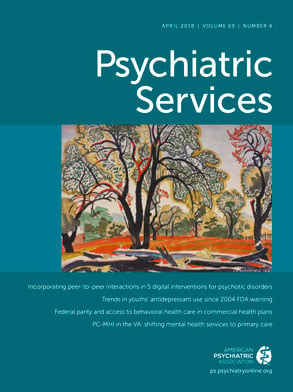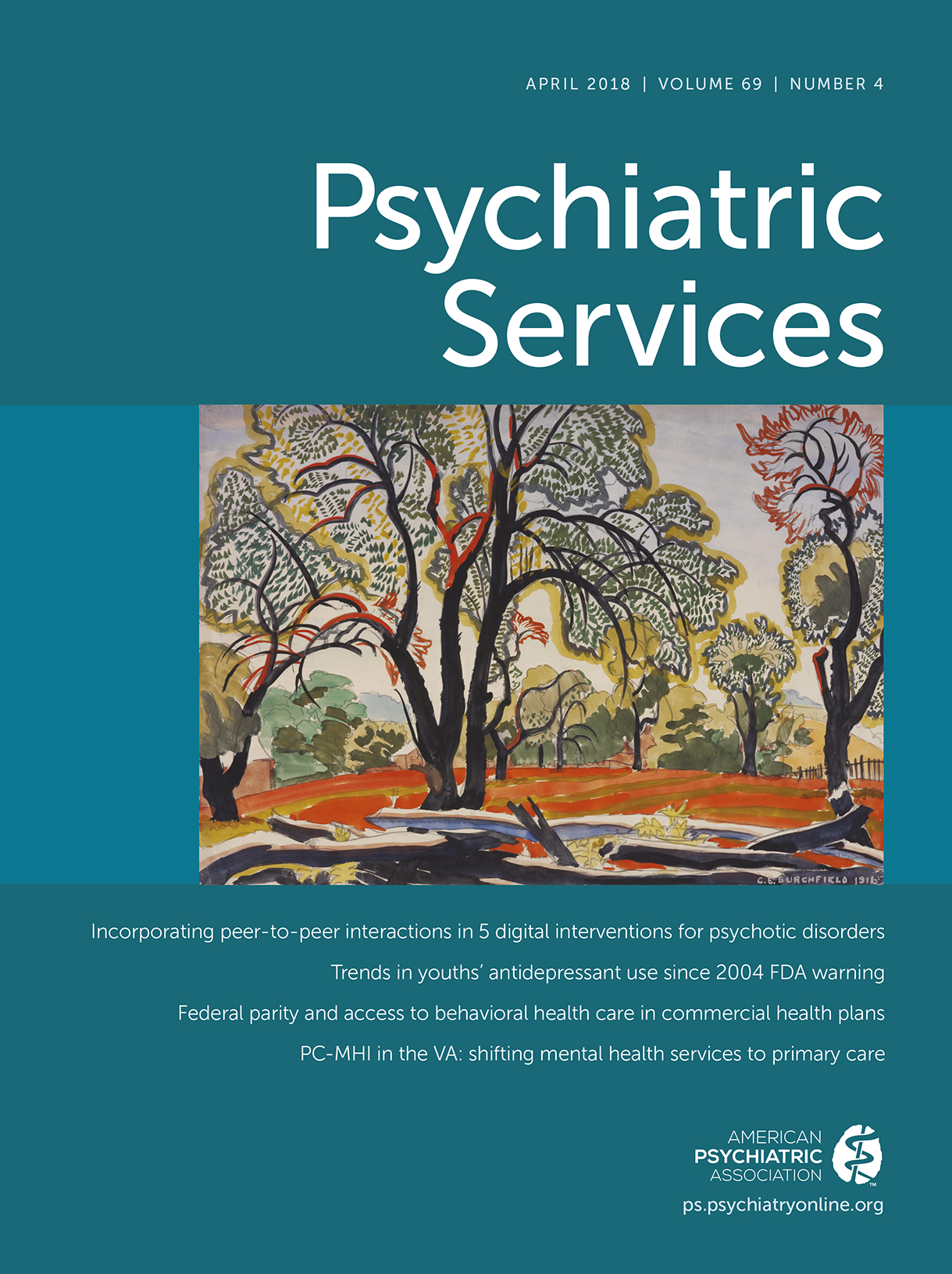Drug overdoses claimed over 630,000 lives in the United States from 1999 to 2016—with opioids involved in more than 350,000 of these deaths—and mortality rates have been increasing annually (
1). In November 2017, the President’s Commission on Combating Drug Addiction and the Opioid Crisis issued a 138-page final report with recommendations to address this “addiction crisis that is rampantly impacting our country” (
2). In their previous interim report, the commission highlighted a critically important point: only about 10% of the nearly 21 million Americans with a substance use disorder in 2015 received any type of specialty treatment (
2). Their final report noted briefly that approximately 90% of the remaining persons with substance use disorders—including almost 17 million American adults who needed, but did not receive, specialty substance use treatment—did not think it was needed (
2,
3). With the vast majority of affected persons not recognizing their need for specialized drug or alcohol care, calls simply to improve the availability of effective treatments, while laudable, may not be sufficient. Thus, many states are turning to civil commitment for substance use disorders as a potential solution.
Approaches to Civil Commitment for Substance Use Disorders
Civil commitment is a legal mechanism that allows family members, health care practitioners, or other persons to seek court-mandated treatment for an individual who poses a substantial threat of harm to self (by overdose, for example) or others—in this case because of having a substance use disorder. Depending on the jurisdiction and a person’s needs, commitment can involve hospitalization, mandatory community treatment, or some combination of the two. Unlike with drug courts, however, individuals need not have criminal justice involvement to be ordered to receive treatment. Thus, civil commitment’s appeal is readily apparent: loved ones and supportive persons in the community do not have to wait for an individual to “hit rock bottom,” face criminal charges, or experience other dire consequences before substance abuse treatment can be imposed.
As of 2015, 32 states and the District of Columbia had laws permitting civil commitment of an adult for substance abuse treatment (
4). Now, due in large part to the alarmingly high—and rising—rate of opioid overdose deaths (
5), more states, such as Pennsylvania (
6) and Washington (
7), are considering enacting similar laws or expanding their existing ones. The idea of such laws, however, is not new. By the early 1800s, many physicians, adopting views of substance abuse as a medical problem rather than a moral failing, began advocating for legislation to allow involuntary substance abuse treatment. The popularity of such laws over the intervening two centuries has waxed and waned depending on the degree to which substance abuse was conceived of as a medical disorder (
8,
9). Even in the absence of legislation, of course, persons with substance use disorders commonly experience some degree of informal coercion to seek treatment from loved ones, employers, licensing boards, or social service agencies (
10,
11). Although addiction experts over the years have supported some involuntary treatment strategies, such as assisted outpatient commitment (
10), arguments about the practical challenges of implementing civil commitment laws and ethical concerns about deprivation of liberty continue to be raised (
5,
11).
Complicating the discussion about civil commitment for substance use disorders is the wide variability of these laws across states (
4,
9). For example, whether an individual is committed to an inpatient or outpatient setting depends on each state’s statute (
4) and is often influenced by local practices and available resources. Moreover, some states allow a maximum initial commitment period of only one month, whereas others allow periods longer than one year. Periods of commitment can vary even within the same state for alcohol compared with other drugs (
4). States may also have detailed provisions targeting particular substances. A recent Senate bill in Washington State, for instance, proposes expanding an existing involuntary substance abuse treatment law to address active heroin use, describing “three or more visible track marks” as evidence of grave disability (
7).
Data on Involuntary Treatment of Substance Use Disorders
Despite the growing interest in civil commitment for substance use disorders in the United States, outcome data regarding these laws have been limited, difficult to generalize, and further complicated by a host of issues, such as the variability in state laws (
4,
9). Utilization rates also differ vastly among states, with many states not even collecting data systematically (
4). A recent review found that Florida and Massachusetts committed thousands of individuals annually (on average 9,000 and 4,500, respectively); in contrast, some states, including Hawaii (83 in 2009), Texas (22 in 2010), and Wisconsin (260 in 2011), committed people less frequently; some states, such as Illinois and Utah, never used their statutes; and others, such as Ohio and Oklahoma, did not have readily available data (
4).
Other recent studies that have examined these laws, including their effectiveness, found mixed results. A private Florida program reported comparable rates of “successful completion” of substance abuse treatment between groups of 100 involuntary and 219 voluntary patients (
12). Similarly, a survey completed by 49 of 72 Wisconsin county representatives found that slightly more than half (52%) believed that commitments for alcohol dependence were effective (
13). However, in a Minnesota study in which interviews were conducted of seven professionals who provided substance abuse treatment services to civilly committed persons, respondents generally shared their opposition to coerced treatment and suggested that it is a poor external motivator (
14). Along the same lines, a national survey of 739 American Psychiatric Association members, as part of a broader inquiry about civil commitment, found that only 22% supported commitment for alcohol or drug abuse treatment (
15). Additionally, a separate Minnesota study describing outcomes of 28 patients for whom commitment was pursued, reported that only seven of these patients were committed to a substance abuse treatment facility, with six of those who were committed relapsing almost immediately after discharge (
16). Although useful in providing some insights, these studies are difficult to apply broadly and are often compromised by vague or absent outcome measures, small sample sizes, subjectivity in assessment, and insufficient detail regarding specific treatments provided during the commitment period.
With limited empirical evidence about these laws, arguments for or against them have generally been extrapolated from studies in other countries, derived from criminal justice system interventions (such as drug courts), or based on civil commitment of individuals with substance use and co-occurring disorders, such as schizophrenia. In short, whether civil commitment improves or worsens the outcomes of those who abuse opioids or other substances is unclear. Commitment may achieve the immediate goal of preventing an overdose or related danger, but whether it leads to sustained recognition of treatment needs by the affected person, engagement in care, and improved decision making remains to be demonstrated. Other outcome questions of interest include whether civil commitment reduces future criminal justice involvement, leads to better occupational and social functioning, and helps to promote autonomous choices. At the same time, there is concern that civil commitment could lead to unintended harms. For instance, if transition to postcommitment community care falters, newly discharged patients may be at elevated risk for overdose, as has been found among inmates who experienced a relapse in use of opioids after release from incarceration (
17). In addition, unwanted commitment to treatment may damage addicted persons’ trust of their families and health care providers, disrupt social functioning, and threaten their employment.
Moving the Debate Forward
Research would undoubtedly help inform the debate about civil commitment, which currently tends to pivot on the justifications for restricting the liberty of persons with substance use disorders. Although normative considerations cannot be resolved by empirical data alone, ethical deliberations could be informed by empirical work on the circumstances under which civil commitment is authorized (diminished autonomy and imminent risk, for example) and the extent to which commitment laws may be misused. Research is also needed on the degree to which civil commitment use may be driven by the limited availability of voluntary, evidence-based treatments, including medication-assisted therapies, in the community.
Well-crafted studies would provide guidance on the appropriate length of civil commitment: that is, are short periods of compulsory care sufficient to mitigate the immediate risks that opioid use poses, or can longer periods of commitment be justified by virtue of leading to sustained engagement in treatment and other risk reduction? Studies could also clarify the crucial questions of which treatment modalities and enforcement mechanisms (consequences for failure to comply) are most effective for involuntary patients and whether effectiveness varies by patient characteristics. Current utilization patterns of civil commitment for substance use disorders call for explanation as well. Systematic assessment of practical considerations, such as who pays for the commitments, how orders are enforced, what kinds of facilities are utilized for involuntary patients, and whether practitioners are aware and supportive of civil commitment (including liability considerations), can provide guidance to policy makers seeking to improve practices in their states.
At present, civil commitment laws for people who misuse opioids and other substances are being introduced and revised, and services organized, in the absence of these data. Clinicians and judges are making decisions to pursue and authorize civil commitment on a case-by-case basis without knowing whether they are promoting or harming the interests of those targeted for involuntary treatment. Thus, health care providers and professional organizations need to collaborate with state lawmakers and local communities to determine the feasibility and effectiveness of these laws. As interest in civil commitment continues to grow, the President’s Commission—which did not mention civil commitment in its report—and other national groups should call attention to the need for studies that carefully examine the outcomes of civil commitment. Rigorous study of existing statutes, and a proactive focus on outcomes-oriented research in states that implement new commitment laws, are critical. Without such research, we will not know if civil commitment can help the large portion of patients who do not recognize the urgent need for treatment of their substance use disorder.

